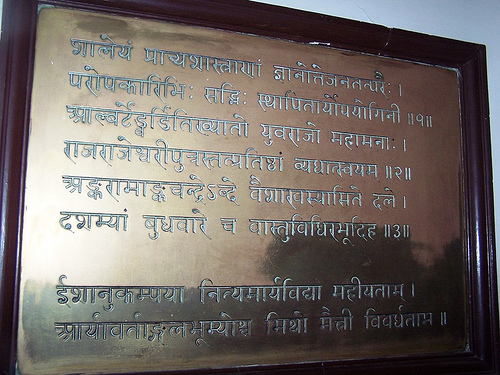Yoga in Plain English.
In most yoga classes I’ve attended, the teacher throws out at least a few—if not a ton—of tongue-twisting Sanskrit syllables.
When I was in yoga teacher training, I remember learning all these new concepts and words. It can be overwhelming, especially at first.
I’m no Sanskrit scholar, but here are some basic translations of several of the common terms used in yoga classes and workshops.
I’m not including names of specific asanas here, because if I did, this list would be a mile long. (Feel free to add other terms in the comments section.)
1) Asana: seat; yoga posture
2) Ashtanga: eight-limbed yogic path; for Ashtanga/Power Yoga, et al, see the relephant Glossary of Popular Yoga Lineages and Styles
3) Ayurveda: the ancient Indian science of health
4) Bandha: internal lock; used for controlling the energy within the body during yoga practice; the three bandhas taught in some lineages of hatha yoga are root lock, abdominal lock and throat lock
5) Bhakti: devotion (as in Bhakti Yoga, the yoga of devotion)
6) Buddha: a buddha is an enlightened one; “the Buddha” refers to Siddhartha Gautama, a spiritual teacher who lived, became enlightened and taught in India a long time ago
7) Chakra: energy center; the basic system has seven chakras (root, sacrum, solar plexus, heart, throat, third eye and crown), each of which is associated with a color, element, syllable, significance, etc.
8) Dharma: truth; the teachings of the Buddha; the path of truth
9) Dosha: physical body type; there are three doshas in Ayuveda—pitta (fire), vata (wind) and kapha (earth)
10) Drishti: gazing point used during asana practice
11) Ganesha: the Hindu elephant god often pops into yoga; also called “Ganesh”
12) Guru: one who brings us from darkness to light; a spiritual mentor
13) Karma: action; the law of karma is the law of cause and effect. Karma is based upon the complex, esoteric web of conditions, individuals and relationships in the universe. It is not just as simple as a notion like “steal from someone and you’ll be robbed.”
14) Karuna: compassion
15) Kirtan: a community gathering involving chanting, live music and meditation
16) Krishna: a Hindu deity; part of the Bhagavad Gita
17) Kula: community
18) Mantra: a repeated sound, syllable, word or phrase; often used in chanting and meditation.
19) Mudra: a hand gesture; the most common mudras are anjali mudra (pressing palms together at the heart) and gyana mudra (with the index finger and thumb touching)
20) Namaste: “I bow to you”; a word used at the beginning and/or end of class which is most commonly translated as “the light within me bows to the light within you”; a common greeting in India and neighboring cultures; a salutation said with the hands in anjali mudra.
21) Niyama: five living principles that (along with the yamas) make up the ethical and moral foundation of yoga; they include Sauca (purity), Santosha (contentment), Tapas (burning enthusiasm), Svadhyaya (self-study) and Ishvarapranidhana (celebration of the spiritual)
22) Om: the original syllable; chanted “A-U-M” at the beginning and/or end of many yoga classes
23) Prana: life energy; chi; qi
24) Pranayama: breath control; breathing exercises
25) Samadhi: the state of complete Self-actualization; enlightenment
26) Savasana: corpse pose; final relaxation; typically performed at the end of every hatha yoga class, no matter what style
27) Shakti: female energy
28) Shanti: peace (often chanted three times in a row)
29) Shiva: male energy; a Hindu deity
30) Surya Namaskar: Sun Salutations; a system of yoga exercises performed in a flow or series
31) Sutras: classical texts; the most famous in yoga is, of course, Patanjali’s Yoga Sutras.
32) Tantra: the yoga of union (much more than just tantric sex that is popularized in the media)
33) Yama: five living principles that (along with the niyamas) make up the ethical and moral foundation of yoga; they include Satya (truth), Ahimsa (nonviolence), Asteya (not stealing), Bramacharya (self control and sexual responsibility) and Aparigraha (not grasping)
34) Yogi/Yogini: a male/female practitioner of yoga.
Want 15 free additional reads weekly, just our best?
Get our weekly newsletter.
Editor: Rachel Nussbaum
Image: Ramona Klee via flickr

 Share on bsky
Share on bsky







Read 3 comments and reply